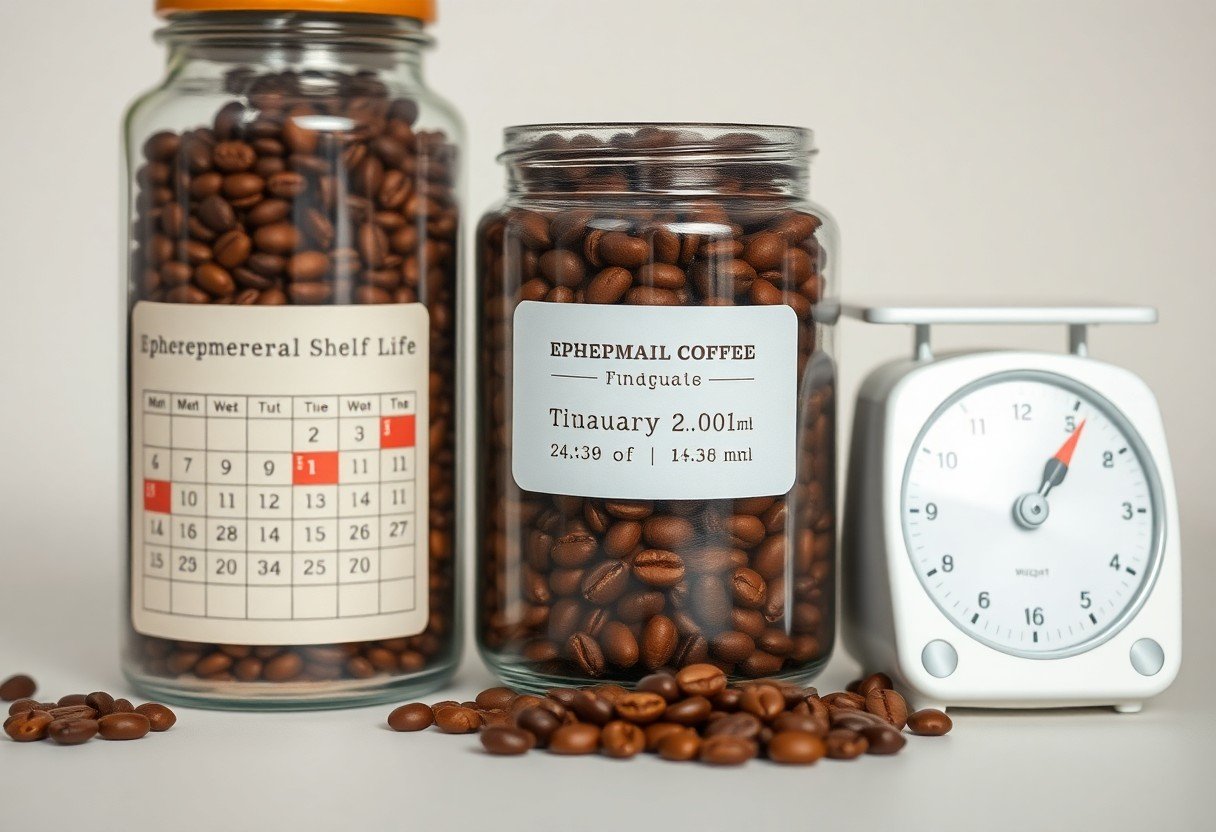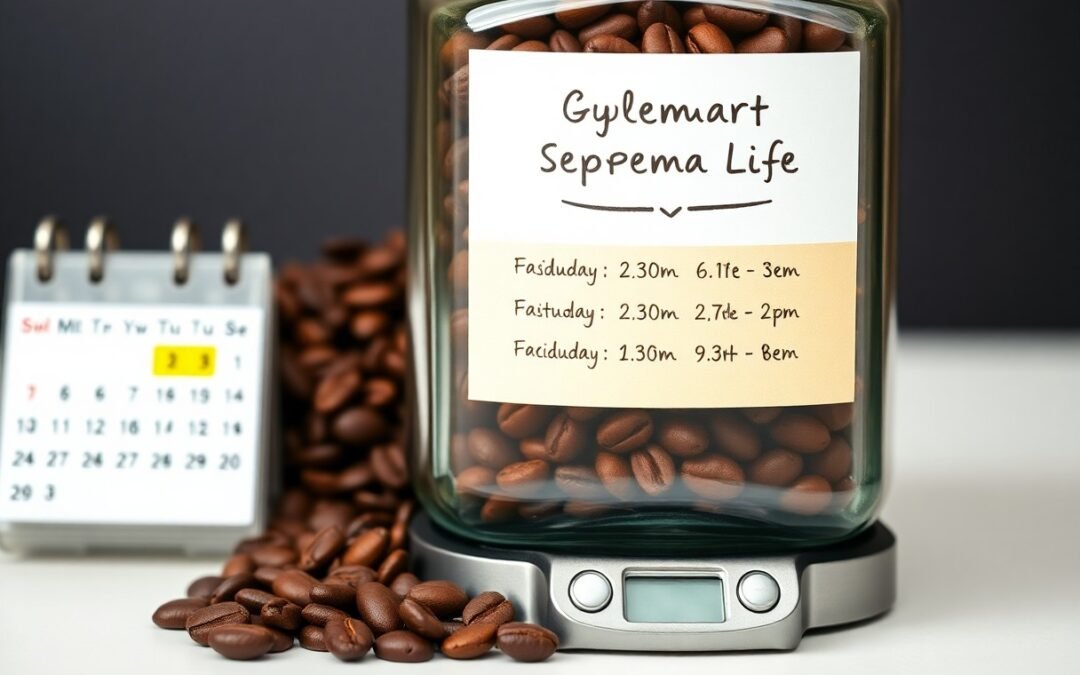There’s a fascinating world behind the shelf life of gourmet coffee beans that you may not fully understand. As you explore your coffee options, it’s vital to know that the freshness and quality of these premium beans can significantly affect your brewing experience. This post will guide you through what factors influence the ephemeral shelf life of gourmet coffee, from roasting dates to storage conditions, ensuring you enjoy the richest flavors in every cup. Discover how to keep your coffee vibrant and delicious for as long as possible.
The Science of Freshness: Factors Affecting Coffee Bean Longevity
The longevity of your gourmet coffee beans hinges on several scientific factors, significantly impacting their freshness and flavor profile. Key elements affecting the shelf life include:
- Humidity levels during storage
- Exposure to light and air
- Type of packaging
- Storage temperature
Knowing how these factors interact can help you preserve the aromatic and flavorful properties of your coffee beans longer.
Chemical Changes During Storage
Coffee beans undergo various chemical transformations during storage, primarily due to exposure to oxygen, light, and moisture. These conditions can lead to oxidation, which diminishes flavor and aroma over time. The oils present in beans begin to rancidify, altering the taste profile and making it less enjoyable. Moreover, the beans can lose volatile compounds responsible for their distinct flavors, resulting in a flat and stale cup of coffee.
The Role of Roast Date in Flavor and Quality
The roast date significantly influences both flavor and quality. Freshly roasted coffee is vibrant, carrying fresh notes and a complex profile that captivates your palate. As time passes, the beans slowly lose their ideal taste characteristics, peaking shortly after roasting and then gradually diminishing in flavor. Typically, gourmet coffee is best consumed within two to four weeks of roasting, during which it retains its aromatic potential.
The Timeframe: Ideal Conditions for Optimal Flavor
Ensuring your gourmet coffee beans maintain their peak flavor involves understanding the ideal timeframe for usage. Typically, coffee beans are best enjoyed within two weeks to a month of roasting. This window allows you to experience the rich aromas and intricate flavors before they begin to fade. Using guidelines based on your brewing method can help further refine your consumption habits, maximizing your coffee experience.
Environmental Influences: Light, Temperature, and Humidity
| Light | Exposure to light causes coffee beans to deteriorate quickly, impacting flavor and aroma. |
| Temperature | Extreme temperatures can damage the oils in the beans, leading to off-flavors. |
| Humidity | High humidity can lead to mold growth, while low humidity can cause beans to dry out. |
Packaging Innovations to Extend Shelf Life
Advancements in coffee packaging technology have been developed to enhance the shelf life of your beans significantly. Options such as vacuum-sealed bags and one-way valve packaging allow carbon dioxide from the fresh coffee to escape while preventing oxygen from entering, thereby preserving flavors longer. Additionally, innovative materials that provide better barriers against light and humidity protect your coffee even further.
These packaging innovations serve multiple functions. For instance, vacuum-sealed bags ensure a tight fit, eliminating air that can lead to quicker degradation. One-way valve systems are particularly effective for freshly roasted beans that emit gas, preventing potential buildup pressure while ensuring flavor remains intact. Overall, investing in high-quality packaging can provide an extra layer of protection for your gourmet coffee, so consider these features when purchasing your next batch. Expanding your knowledge of these options will empower you to make better choices for coffee storage and preservation.
The Art of Brewing: When to Use Gourmet Beans
Choosing the right moment to brew gourmet coffee beans enhances your experience significantly. These high-quality beans shine best when prepared with care shortly after roasting and grinding. Using them in brewing methods that highlight their complex flavor profiles, such as pour-over or French press, allows you to fully appreciate their unique taste attributes.
The Impact of Brew Methods on Flavor Profile
Your choice of brewing method directly influences the flavor profile of gourmet coffee. Techniques such as espresso brewing extract rich, bold flavors quickly, while slower methods like cold brewing yield a smoother, more delicate taste. Each method interacts uniquely with the aromatic oils present in your beans, which enhances or diminishes specific flavor notes.
Maximum Flavor Window: Timing Your Brew for Best Results
Timing your brew is equally important to unlock the maximum flavor potential of gourmet coffee beans. Ideally, you should brew within two to four weeks of the roast date to achieve the freshest taste, while grinding just before brewing helps preserve those delicate flavors.
Gourmet coffee beans, with their intricate flavor profiles, reach their peak impact shortly after roasting and lose vibrancy as time passes. Aim to brew within the two to four-week window because aromatic compounds begin to diminish after this period. Grinding beans immediately prior to brewing ensures the release of fresh oils and gases, aligning with optimal brewing practices to create a delicious cup. This careful timing enhances your coffee’s nuances, making each sip a distinctive tasting experience. By paying attention to these details, you ensure that your gourmet coffee truly delivers on its promise of excellence.

Consumer Misconceptions: Debunking the Myths
Many misconceptions about gourmet coffee beans persist, leading to confusion among consumers. One prevalent myth is that all coffee beans, whether dormant or expired, can be safely consumed without consequences. This notion underestimates the impact of freshness on flavor and aroma, often resulting in subpar brews and a lack of appreciation for high-quality beans. Understanding the reality behind these misconceptions is imperative for enjoying the full sensory experience that gourmet coffee has to offer.
Myth vs. Reality: Is Expired Coffee Safe?
Expired coffee may not necessarily pose a health risk, but it can significantly diminish your coffee experience. While stale coffee isn’t harmful like spoiled food, the flavors and aromas are often flat or unpleasant, leading to a disappointing cup. For optimal taste and enjoyment, using coffee beans within their recommended shelf life is always best.
The Coffee Snob Dilemma: How Fresh is ‘Fresh Enough’?
The definition of freshness can be subjective when it comes to coffee, especially among enthusiasts and self-proclaimed coffee snobs. The debate often centers around the ideal time frame between roasting and consumption. Generally, coffee is at its peak flavor within 1-2 weeks post-roasting, but many aficionados advocate for even leaner timeframes. You might find that your personal taste might lean towards different grinding and brewing methods, further complicating what ‘fresh’ means to you.
How fresh is ‘fresh enough’ varies significantly among coffee drinkers. For some, beans roasted just a week ago deliver the ultimate flavor, while others might tolerate beans that are up to a month old, especially for certain brewing methods that can mask minor staleness. Factors like storage conditions and brewing technique also play a vital role in maintaining freshness. Take note that as beans age, they lose volatile compounds imperative for flavor, which is why experimenting with different roasts and timelines will help you discover your ideal freshness threshold. Keeping track of your purchase dates and sampling beans from different sources can refine your palate and enhance your coffee enjoyment.
Best Practices for Home Storage: Keeping Your Beans Pristine
To maintain the quality of your gourmet coffee beans, proper storage techniques are non-negotiable. Avoid placing beans in clear containers or near heat sources, as both can diminish flavor. Instead, opt for airtight containers made of opaque materials stored in a cool, dark place, where humidity and temperature fluctuations are minimized. Regularly check your beans and portion out only what you need for a week to keep the rest preserved for longer. Following these simple practices can help you enjoy every rich cup of coffee at its peak flavor.
Optimal Storage Solutions for Maximum Freshness
Selecting the right storage solution plays a significant role in preserving the freshness of your coffee beans. Airtight containers, such as vacuum-sealed bags or ceramic jars, work effectively to limit exposure to air and moisture. For added protection, consider storing your beans in a dedicated coffee canister equipped with a CO2 valve, which allows gases to escape while keeping oxygen out. Proper storage ensures that your coffee maintains its rich aroma and flavor profile for a more extended period.
Signs to Look Out For: Recognizing Deterioration
Noticing changes in your coffee beans can prevent a disappointing brew. Keep an eye on the color, aroma, and texture of the beans. If they appear dull, have lost their vibrant color, or if they emit a rancid smell, these are signs of deterioration. Fresh beans should be aromatic, and any noticeable change can signal staleness or spoilage. Taste also provides insight; if your brew lacks its usual complexity or has an off-flavor, it may be time to replace your beans.
In detail, assessing the freshness of your coffee beans involves a few key observations. Fresh beans typically have a glossy sheen due to the oils released during roasting. As they age, this sheen diminishes, indicating a loss of flavor compounds. Additionally, if you notice no scent when you open the container or a musty aroma, these could be signs that your beans have oxidized or absorbed moisture, compromising their quality. By identifying these signs promptly, you can ensure that your coffee experience remains exceptional, with each cup delivering the desired taste immersion.
Final Words
To wrap up, understanding the ephemeral shelf life of gourmet coffee beans is necessary for preserving the rich flavors and aromas you love. Typically, you can expect optimal freshness for about two to four weeks after roasting, with gradual flavor degradation thereafter. To ensure your coffee maintains its quality, store it in an airtight container away from light, heat, and moisture. By being mindful of these factors, you can enjoy the full experience of your gourmet coffee for as long as possible.
Q: What does ephemeral shelf life mean in relation to gourmet coffee beans?
A: Ephemeral shelf life refers to the short-lived freshness and optimal quality of gourmet coffee beans. Unlike standard coffee, gourmet coffee is often made from higher quality beans and is typically more sensitive to factors such as air, light, moisture, and temperature. This means that once opened or roasted, gourmet coffee beans can start to lose their flavor and aroma quickly, usually within a few weeks, making it vital to consume them promptly for the best experience.
Q: How can I extend the freshness of my gourmet coffee beans?
A: To prolong the freshness of gourmet coffee beans, store them in an airtight container in a cool, dark place away from direct sunlight and heat sources. Vacuum-sealed containers are ideal, as they minimize exposure to air. Additionally, consider purchasing whole beans instead of pre-ground coffee, as grinding increases the surface area and leads to faster degradation of flavor. Only grind the amount you plan to use immediately to ensure maximum flavor retention.
Q: What are the signs that my gourmet coffee beans have gone stale?
A: Staleness in gourmet coffee beans can be detected through several signs. First, the aroma will be weak or diminished, lacking the rich, fragrant scent of fresh coffee. Second, the flavor will taste flat or lack complexity, indicating that oils have oxidized or evaporated. Lastly, if you notice any unusual color changes or a loss of texture, it may be time to replace your beans. Consuming stale coffee will not only result in a disappointing cup but may also fail to provide the intended tasting notes characteristic of gourmet quality.

